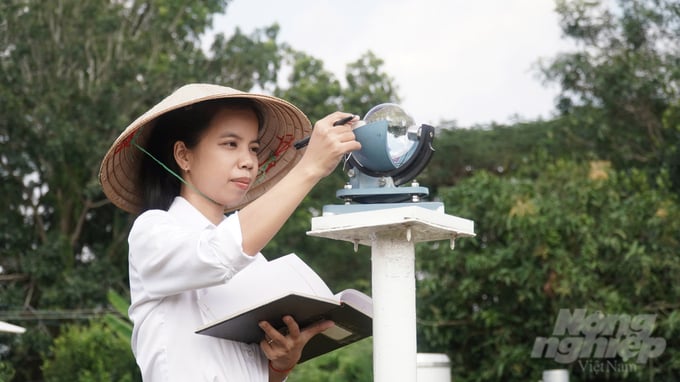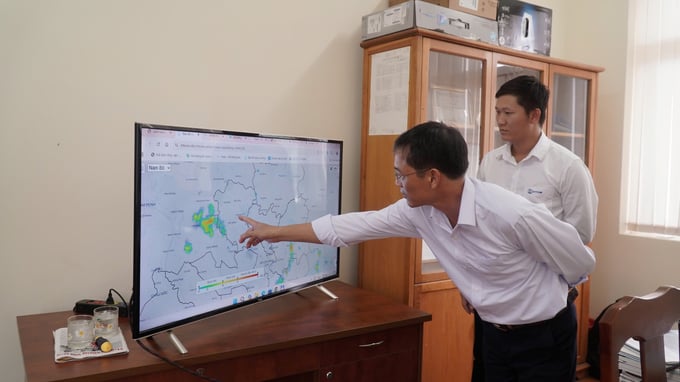November 9, 2025 | 20:50 GMT +7
November 9, 2025 | 20:50 GMT +7
Hotline: 0913.378.918
November 9, 2025 | 20:50 GMT +7
Hotline: 0913.378.918
Located in the Southeast region, Tay Ninh Province is less susceptible to the effects of storms and other adverse weather conditions. However, with a relatively extensive network of canals, the region faces localized flooding among other types of natural disasters, such as tornadoes.

An automated monitoring system at the Meteorological and Hydrological Station in Tay Ninh Province. Photo: Tran Phi.
According to meteorological and hydrological records, Vietnam experienced 10 storms in the first 11 months of 2024. Despite avoiding the severe impacts of Storm No. 3 (Yagi), Tay Ninh experienced 18 heavy rainstorms and localized tornadoes, which caused extensive damage across six districts and two towns. Reported losses included 78 damaged or flooded houses, 143 hectares of affected crops, and other damages.
Recognizing the critical importance of meteorological and hydrological (M&H) data in forecasting, disaster prevention, and promoting climate resilience, the Meteorological and Hydrological Station in Tay Ninh Province has gradually upgraded its network of automated weather monitoring systems. The goal is to transition from manual measurements to Industry 4.0 technologies, thereby facilitating early warnings and enabling local authorities and residents to proactively prevent and mitigate disaster impacts.
A visit to the Meteorological and Hydrological Station in Tay Ninh Province highlights the adoption of new technological solutions, including artificial intelligence (AI). Accordingly, this technology has enhanced operational efficiency and forecasting and warning capabilities. Furthermore, it provides significant support to disaster prevention efforts across districts and towns in the province.

An officer at the Meteorological and Hydrological Station in Tay Ninh Province operating a monitoring equipment. Photo: Tran Trung.
Thanks to automated tools for data collection and analysis, such as Himawari satellite cloud images, weather radar, a data assimilation system for the high-resolution WRF weather forecasting model, and tools for weather map analysis and digitization, the Meteorological and Hydrological Station in Tay Ninh Province has achieved increasingly accurate forecasts. These tools are useful for monitoring and predicting hazardous weather phenomena that occur over short periods, such as heavy rains or urban flooding.
"One of the most important applications of science and technology in disaster prevention is the forecasting and warning of natural disasters. Accurate predictions of timing, intensity, and development of disasters enable local authorities to respond promptly and effectively, thereby minimizing losses," said Nguyen Huy Kha, a forecaster at the Meteorological and Hydrological Station in Tay Ninh Province.

The Meteorological and Hydrological Station in Tay Ninh Province utilizes various new technological solutions, including artificial intelligence. Photo: Tran Phi.
Le Xuan Hoa, Deputy Director of the Meteorological and Hydrological Station in Tay Ninh Province, explained that due to the varying data structures of different rain gauge stations, data standardization under a unified format is critical. After all information from the automated stations is collected, a comprehensive database is built.
"After completing the database, we will develop a website to display, extract and manage the collected rainfall data. The website will integrate a three-layer map, including a base layer with coordinate information, a layer showing the locations of rain gauge stations, and a layer for rainfall observation data. This will make data analysis and extraction much more convenient," Hoa shared.
Deputy Director Hoa also noted that the system has produced promising results during the trial period. With its full functionality, the system can capture and process high-quality images even in low-light conditions or adverse weather such as rain.
"In the digital era, utilizing technological platforms to enhance disaster prevention readiness has been a priority for the meteorological and hydrological sector. Despite existing challenges, this approach is essential and must be further promoted," Deputy Director Hoa emphasized.
Similarly, Thanh Hoa province, located in Vietnam's North Central region, is home to four main river systems: Hoat, Ma, Bang, and Yen rivers, with a total length of 881 kilometers. The river basins cover an area of over 39,000 square kilometers, with an average annual water volume of 19.52 billion cubic meters.
Additionally, Thanh Hoa has an extensive reservoir system with 610 reservoirs, ranking second nationwide after Nghe An province. This includes one critical reservoir of national security significance, Cua Dat, as well as hydropower reservoirs within the Ma River basin. Consequently, monitoring water levels in rivers and reservoirs plays a vital role in disaster prevention efforts in the province.
To proactively manage operations, issue flood warnings, and implement disaster response plans, Thanh Hoa Province's Sub-Department of Water Resources has installed a camera system to monitor water levels at nine key locations. These cameras track river water levels and the status of dike systems.
The camera system, integrated with computers and supporting applications, enhances the proactive flood warning capabilities of the provincial flood and storm prevention agency, enabling more effective disaster prevention and response planning.
Translated by Nguyen Hai Long

(VAN) From relying on imported sources, Viet Nam’s crop sector has mastered breeding technologies, turning into a foundation for biosecurity.

(VAN) When farmers begin to observe rather than spray, to listen rather than react, the crop sector embarks on a new journey of nurturing plants, soil, and the entire ecosystem.

(VAN) The development of green, circular, and organic agriculture is becoming an essential direction for the Mekong Delta, helping farmers cut costs, boost profits, and build a sustainable production system.

(VAN) Eighty years of agriculture and environmental development in the Mekong Delta tell a story of constant adaptation and transformation - all driven by the shared goal of harmonizing production with environmental protection.

(VAN) Sustainable coconut cultivation is the key to achieving balance among three pillars: economic efficiency, ecological safety, and consumer trust.

(VAN) A wood pellet factory has been supporting forest growers certified under FSC standards to improve their income and promote sustainable forest protection.

(VAN) Associate Professor Dr. Pham Anh Tuan emphasized that clearly identifying target groups, production scale, and consumer markets is key to ensuring the sustainable development of Viet Nam’s coconut industry.